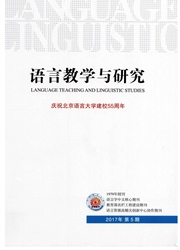

 中文摘要:
中文摘要:
本文以生成词库论中的物性结构体系为理论背景,对现代汉语中的三音节偏正名名复合词进行了内部的语义分析。本文认为,复合词内部物性结构与其整体韵律模式有重要关联,在1+2式的名名复合词中,定语名词充当了中心名词的构成角色或形式角色;而在2+1式名名复合词的大多数例子中,定语名词和中心名词之间存在隐含动词,而这个隐含动词为中心名词的功用角色。
 英文摘要:
英文摘要:
Based on the qualia structure system in Generative Lexicon Theory, this paper gives a semantic analysis on the inner structure of Mandarin trisyllabic noun--noun compounds(NNC). It reveals that the rhythm pattern of trisyllabic NNCs has significant correla- tion with their qualia structures. In "1+2" (monosyllable + disyllable) pattern, the monosyllabic modifier noun always serves as a constitution role or formal role for the disyllabic head noun, while in "2 + 1" (disyllable + monosyllable) pattern, there exists an implicit predicate serving as a telic role for the monosyllabic head noun.
 同期刊论文项目
同期刊论文项目
 同项目期刊论文
同项目期刊论文
 期刊信息
期刊信息
